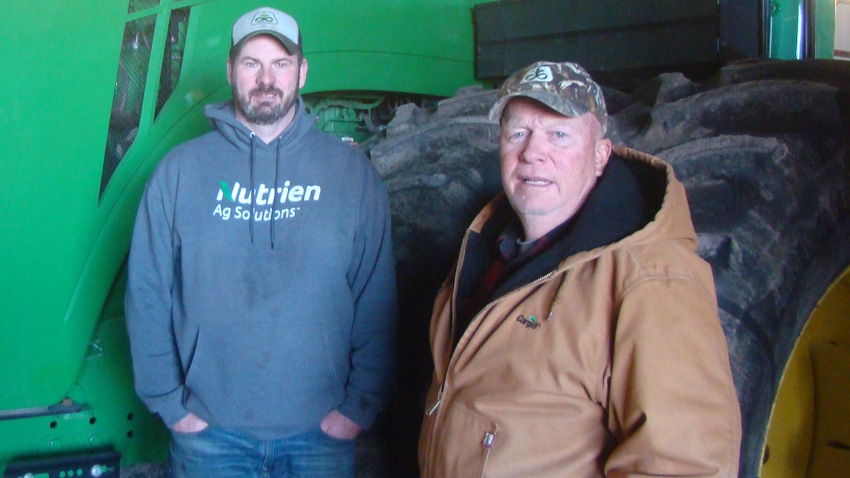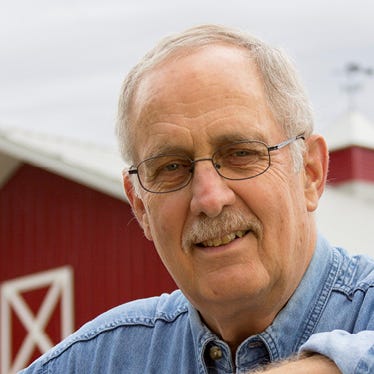April 14, 2023

Tom Murphy, 44, can’t remember when he wasn’t interested in farming. “As a little kid, I played with toy tractors all the time,” he says. “Then when I was a little older, I spent a lot of time hanging out with a neighbor farmer, Willy Harders. I never wanted to be anything but a farmer.”
After high school, Murphy worked on a dairy farm and drove a truck. A friend asked Murphy if he’d like to drive a truck for his dad, Gary Dunlap, Valparaiso, Ind. Dunlap is a farmer who also owned a fleet of trucks. So, Murphy made the switch in 2005, trucking and helping on the farm during busy seasons.
In 2016, Dunlap was getting out of the trucking business and approached Murphy with an interesting proposal. “How would you like to begin the process of eventually taking over my operation?” he asked.
“I immediately said yes, so we sat down and worked out a timeline and ideas, and came up with a plan,” Murphy says. “Gary has the option of staying involved as long as he’s still enjoying it.”
Different farm transition plan
Their operation consists of about 3,000 acres, all rented, plus some acres Murphy owns. Dunlap owns 7 acres, which includes his house, grain bins and the hub of the operation. With the help of one employee and harvest truckers, they raise commodity corn, high-amylose corn and soybeans. The two are jointly involved in management of the operation, in what is essentially a long-term internship for Murphy.
The norm is for farms either to be passed down through the family, generation to generation, or sold. But Dunlap, now 68, believes that transitioning his operation to an unrelated, first-generation farmer offers appealing nontangible benefits.
“Farming with family can be real tough,” he says. “I know of situations where dads and sons get in a lot of arguments, and sometimes you must appease a daughter-in-law or grandchild. That’s just the way it is.
“What happens then is that you wind up making decisions based on the family, rather than making a good business decision. A lot of times it’s easier to deal with nonfamily.”
Making the management shift
About five years ago, Dunlap sent a letter to each of his many landlords, informing them of the transition plan, and asking them to refer any questions to Murphy. None of the owners had a problem with it, although some still contact Dunlap.
At this point, Dunlap describes himself as “about 85% full time,” with the option to gradually dial that back as health or other factors come into play. He had a mild stroke in May ’22 and was hospitalized for a week, during which Murphy had to make even more decisions on his own. The plan is for Murphy to gradually assume full decision-making for the operation.
Tips for transitioning
Dunlap and Murphy share some tips to help anyone who might consider this option:
Find the right person. It helps if both parties share a common work ethic.
“You can’t just interview somebody and get started,” Dunlap says. “Tom worked for me for 11 years, and I knew him very well. I knew that he wasn’t somebody I’d have to push to get things done. It’s a whole lot easier to pull someone back occasionally. I’ve also heard of situations where people tried this, only to find out the new person only wanted to work 9 to 5 and be off every weekend. If they’d known each other well first, they would have both seen it wouldn’t work.”
Communicate, communicate, communicate. Communication is always a key.
“We communicate multiple times every day, and most of our conversations begin with, ‘What do you think?’ Murphy says. “Then we bounce ideas off each other. When I meet with my banker, we do it right here with Gary present; that way, everyone knows what’s going on. When Gary had his stroke last May, Mike [employee] and I were up there in the hospital about every day, talking things over.”
“When I propose something, I suggest it — not, ‘We’re going to do this.’ Dunlap adds. “Otherwise, it’s like an employer-employee relationship. It can’t work that way.”
Expect disagreements. They will happen. Attitude matters!
“No two people agree on everything, and we butt heads frequently,” Murphy says. “But if one of us starts getting upset, we just walk away and cool off, then come back to it. I don’t remember very many situations where we haven’t been able to work out a solution.”
“We probably agree 90% of the time, and you have to forget the other 10%,” Dunlap says. “Hopefully after a day, it’s water under the bridge.”
Delegate decisions. One-person rule won’t work.
“Gary’s been good about allowing me to try new things,” Murphy says. “He’s let me experiment with nutrient management, and we’ve started doing more foliar applications. A few years ago, we had the opportunity to raise sorghum for a niche market. It was my idea, and he let me run with it. It was doing well till I saw flames coming out of the dryer, so we dropped it.”
Find the right legal structure. Put details in writing.
“It’s important to have everything down in writing, and we worked with a lawyer,” Dunlap says. “The best legal structure for us was a joint venture, rather than a partnership, which is a lot more structured. The joint venture allows us to do what we want it to do. It’s set up so that if, say, either of us got a divorce, the farming operation would not be affected. We also have an escape clause, if either of us wants out. If I become incapacitated, no one can come in and shut it down.”
“During the process of setting up the joint venture, Gary and I each did drafts of what we wanted,” Murphy explains. “It took two or three drafts to get there, but in the end, we were both satisfied.”
Appreciate what the other brings. Capitalize on strengths.
“I’m not that computer savvy. But Tom is into newer technology, which is a big help. Plus, physically, he can do a lot of things I just can’t do anymore,” Dunlap says.
Murphy notes, “He’s pretty good at grain marketing, and he’s taught me a lot about options, and how you have to make a plan and stick to it.”
Create a win-win. The arrangement must work for both parties.
“It’s a way to keep going and be involved in smaller ways as my health permits,” Dunlap says. “Otherwise, I’d just have had a sale. I probably would have made more money with a sale, but I would have hated to see my whole life’s work that I spent 40 years building just disappear.”
“Without Gary’s help, I wouldn’t have been able to go into farming,” Murphy says. “I’d probably either be driving a truck or working in a steel mill, neither of which I would enjoy. Gary’s been very good to me.”
Boone writes from Wabash, Ind.
Read more about:
Farm TransitionAbout the Author(s)
You May Also Like






